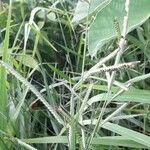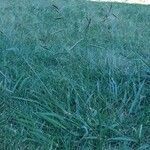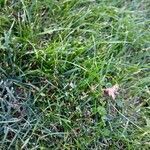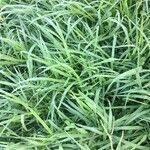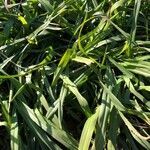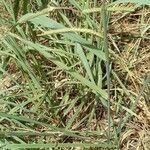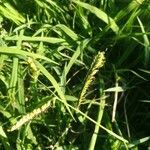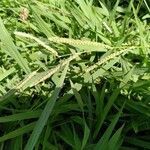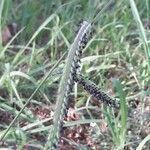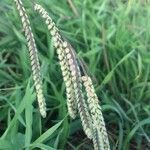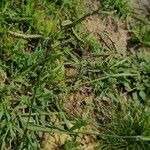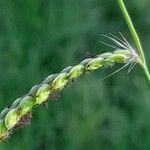Tufted perennial, 0.3-1.8 m high; rhizome short and creeping; basal sheaths glabrous or sometimes hairy; culm nodes glabrous. Leaf blade 90-350(-450) x 6-14 mm; ligule a conspicuous unfringed membrane. Inflorescence of (3)4-9 secund racemes, scattered up a 30-200 mm long central axis; spikelets arranged in 4 rows on one side of rachis; lower glume abaxial, upper lemma facing rachis. Spikelets 3-4 x 2.0-2.5 mm, dorsiventrally compressed, awnless, yellowish green to purplish, matt; glumes unequal; lower glume absent; upper glume fringed with long white hairs around margins, 5-nerved. Florets 2; lower floret sterile, lemma equal and similar to upper glume but flat on back; upper floret bisexual, lemma similar in texture, to firmer than glumes, papillose-striate, obtuse, entire, faintly nerved, glabrous, indurated, margins narrow and inrolled, clasping only edges of palea, pallid at maturity; anther 1.2-1.5 mm long. Flowering time Oct.-May.
Perennial from a short rhizome. Culms forming a coarse, spreading tuft, 50–150 cm tall, ca. 5 mm in diam., glabrous. Leaf sheaths glabrous or pilose in the lower part; leaf blades linear, 10–45 × 0.3–1.2 cm, glabrous, apex attenuate; ligule 2–4 mm. Inflorescence axis 2–20 cm; racemes 2–10, 5–12 cm, spaced, diverging, axils pilose; spikelets paired; rachis 1–1.5 mm wide, glabrous. Spikelets green or purplish, broadly ovate, 3–4 mm, sharply acute; upper glume membranous, 5–9-veined, sparsely pubescent to almost glabrous on back, margins fringed with long white hairs; lower lemma similar but not hairy; upper lemma pallid at maturity, orbicular, ca. 2 mm, clearly shorter than spikelet, papillose-striate, apex rounded. Fl. and fr. May–Jul. 2n = 40, 50–63.
Tufted perennial 300-1 800 mm high; rhizome short, creeping; basal sheaths glabrous or sometimes sparsely hairy; culm nodes glabrous. Leaf blade 90-350(-450) x 6-14 mm; ligule 2-8 mm long, conspicuous. Inflorescence central axis 30-200 mm long; racemes (3)4-9, scattered on the axis; spikelets arranged in four rows on one side of the rachis (secund). Spikelet 3-4 x 2.0-2.5 mm, yellowish-green to purplish, matt; lower glume absent; upper glume fringed with long white hairs along margins, 5-nerved; upper lemma papillose-striate, pallid at maturity; anther 1.2-1.5 mm long.
Stout, erect, 8–15 dm; foliage glabrous, or the lowest sheaths sparsely villous; blades to 3 dm, 8–12 mm wide; racemes 3–6, spreading or ascending, 8–12 cm, the panicle much surpassing the reduced upper lf; spikelets ovate, acute, 2.9–3.8 mm; glume pubescent and near the margin long-villous; sterile lemma nearly glabrous; fertile lemma shorter and blunt; 2n=40, 50, 60+. Pastures, waste ground, and occasionally in moist fields or woods, native of S. Amer., cult. and widely escaped in s. U.S., extending n. to Ky. and in the coastal states to N.J.
Perennial, rhizomatous (rhizome short and creeping) or tufted, up to 1.8 m high. Leaf blades 90-350(-450) mm long, 6-14 mm wide; ligule conspicuous, membranous, 2-8 mm long. Basal sheaths glabrous or sometimes hairy. Spikelets 3-4 mm long, 2.0-2.5 mm wide. Inflorescence with central axis 30-200 mm long; racemes 4-9, scattered on axis; spikelets fringed with white hairs and arranged in 4 rows on one side of rhachis.
Perennial; up to 1.8 m high; rhizome short and creeping; or tufted. Leaf blades 90-350(-450) x 6-14 mm; ligule conspicuous; membranous; 2-8 mm long; basal sheaths glabrous or sparsely hairy. Flowers: inflorescence digitate with central axis 30-200 mm long; racemes 4-9; scattered on axis; spikelets 3-4 x 2.0-2.5 mm; fringed with white hairs and arranged in 4 rows on one side of rachis.
Rhizomatous perennial, up to 2 m tall; base hairy. Leaves linear; ligule an unfringed membrane. Inflorescence of 4-9, 1-sided racemes scattered up central axis. Spikelets in 2-4 rows, 3-4 mm long, green, ovate, margins fringed with white hairs, awnless; glumes unequal, lower occasionally absent; 2-flowered; lower floret sterile, soft; upper lemma hard, pallid.
Rhizomatous perennial to 2 m. Leaves lanceolate. Spikelets in 4-9, subdigitate, spike-like branches, secund, in 4 rows, 3-4 mm long, fringed with white hairs.
